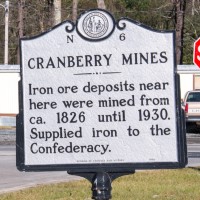Cranberry Iron Mines
History
Author:
Iron for the Confederacy
During the Civil War, natural resources such as salt, lead, and iron were highly prized commodities in the Confederacy. The government relied especially on small rural ironworks for the metals needed to manufacture cannons, swords, and firearms. Ruben White first mined iron ore in the present day Avery County area in the 1780s. By 1860, the Cranberry Iron Corporation operated a bloomery forge on Cranberry Creek. Jordan C. Hardin ran the mine, and his father, John Hardin, was the local postmaster.
In a bloomery forge, burning charcoal melted the iron from the ore. Workers used an iron bar to stir and gather the resulting mass, which was carried to the forge and hammered to drive out impurities, and then further hammered into flat bars of iron.
Forty to sixty men were employed at Cranberry during the war, mining ore and forging iron for the Confederacy. Once a month, the bar iron was loaded in a wagon, and Peter Hardin, a local slave, drove the wagon down the mountain to Camp Vance, near Morganton. There, the iron was loaded on a train and transported to foundries throughout the South that produced munitions for the war effort.
Following the war, the Cranberry mine property changed hands several times. Former Confederate Gen. Robert F. Hoke owned the operation for several years, and he and his associates incorporated the Cranberry Iron and Coal Company in 1873. The mine was worked sporadically through the first half of the twentieth century.
Cranberry Mines

Marker ID: N6
Google Map
NC Highway Map
Nearest Town: Cranberry, NC
Date Cast: 1939
Audio: Iron for the Confederacy
Marker Text
N6 – Cranberry Mines
Iron ore deposits near here were mined from ca. 1826 until 1930. Supplied iron to the Confederacy.
Essay
The iron ore in present-day north-central Avery County, at the town of Cranberry, was mined from around 1826 until the 1930s. The deposits were some of the largest in North Carolina, and the mines actively supplied the state with a majority of its iron ore over the period. The activity was especially important during the Civil War when the Cranberry Mines provided iron for the Confederacy.
Located about three miles from the Tennessee border, the town of Cranberry was named for Cranberry Creek, which flows through the area. The town, known for the large quantities of cranberries that grew naturally in the area, developed in conjunction with the mine and forges. The town’s and the mines’ heyday occurred after the arrival of the Eastern Tennessee and Western North Carolina railroad from Johnson City in 1882.
The Cranberry ore bank, a large subterranean deposit of titaniferous magnetite, is on the western slope of Iron Mountain. It is believed that the American Indians mined the iron deposits in prehistoric times. White settlers discovered the iron deposits in 1781. The Cranberry Mine mainly worked as a surface mine from the 1820s until the 1880s, at which time it opened to more subsurface exploration.
The deposits, of extremely high quality, were originally mined on a small scale. The iron ore was pure, coarse granular magnetite, and the deposits were enormous, with an outcrop 1500 feet long and at times 800 feet wide. Production remained limited during the first fifty years of the mine’s operation. The boost came with the Civil War when the mines played a vital role in providing iron to the Confederacy. Iron was essential for the production of ammunition and weaponry, and for transportation.
In 1882 the railroad opened from Johnson City, Tennessee, to Cranberry. The narrow-gauge railroad facilitated the massive expansion of production, leading to the industrialization of the area. The railroad facilitated the movement of the iron ore to the furnaces, allowing for faster production. The mine was most active from the incorporation of the railroad until around 1930 when iron production in North Carolina began to dwindle.
References:
- John P. Arthur, The History of Western North Carolina (1914)
Ina and John Van Noppen, Western North Carolina Since the Civil War (1973) - John C. Inscoe, The Heart of Confederate Appalachia (2000)
Catherine W. Bishir, Michael T. Southern, and Jennifer F. Martin, A Guide to the Historic Architecture of Western North Carolina (1999) - William S. Powell, ed., Encyclopedia of North Carolina (2006)
- William S. Powell, North Carolina Gazetteer (1968)
Related Articles
- General Robert F. Hoke (coming soon)
- Bloomery Forge (coming soon)
